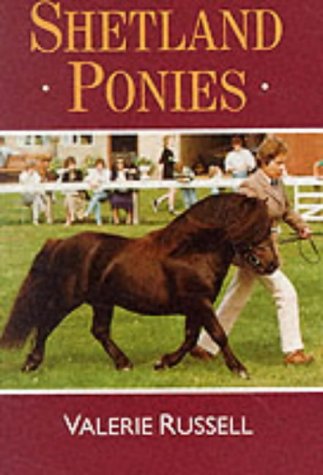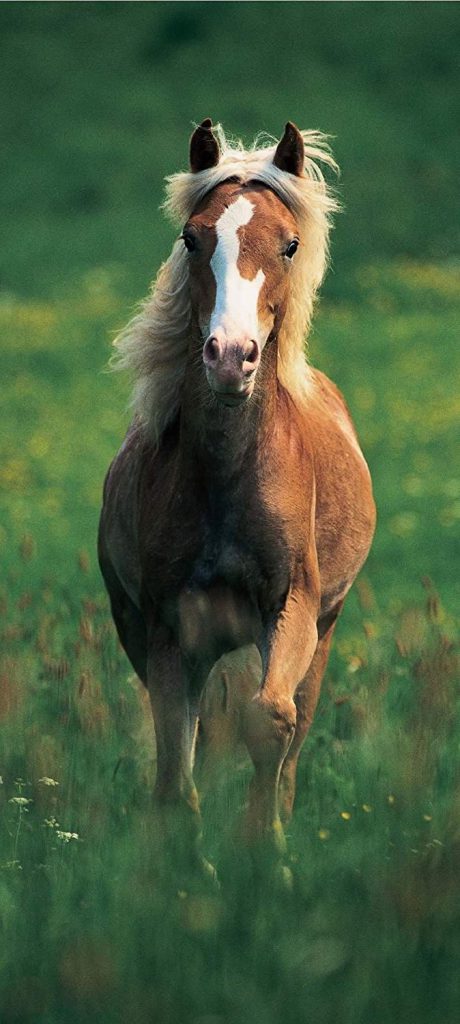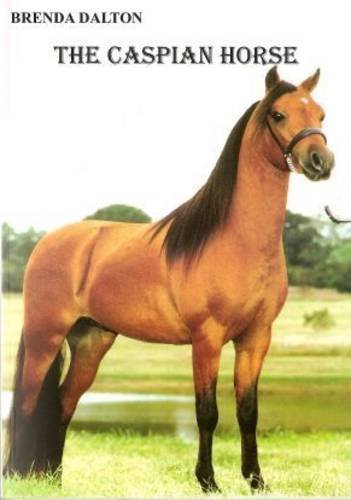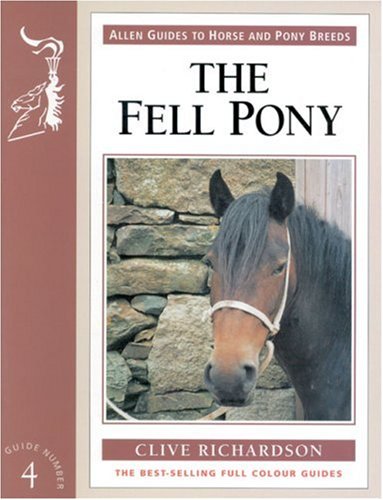Ponies and small horses are not usually larger than 58 inches tall ( 14.2 hands and under) . Some examples are: Shetland, Haflinger, Caspian, Fell, Fjord and Chincoteague ponies.
Shetland

Shetland Ponies (Horses & ponies)
Originating in the Shetland Islands, Scotland, the breed is adapted to the islands’ harsh climate and scant food supply.
For at least 4000 years, in comparative isolation, these fascinating small ponies have roamed the exposed hills and moors of Shetland. This unrestricted lifestyle has led to the evolution of a unique and hardy breed, befitting the environment.
From the 1840s, Shetland ponies began to be used in British coal mines as new laws forbade the employment of women, girls and, later, boys. Hardy, resilient and very strong for their size, the ponies made ideal substitutes as they were able to pass through low underground tunnels hauling truckloads of coal.
These captivating creatures stand up to 42 inches, or 107 cms, high at four years old or over. Charming and instantly recognisable, the ponies can be seen in any colour known in horses except spotted.
The coat changes according to the seasons: a short summer coat which should carry a beautiful silky sheen and, by contrast, a double coat in winter with guard hairs to shed the rain. This thick winter coat, coupled with a profuse mane and tail help to protect the pony against the often harsh conditions of the islands.
With the exception of certain dwarf ponies resulting from genetic mutation, the Shetland is the smallest breed of horse. The average height is about 102 cm (40 inches; unlike other horses, Shetlands are not measured in hands). Maximum height is 117 cm. Shetlands are long-lived and need little care; they are gentle and even-tempered if properly trained.
Today, Shetland ponies are talked about the world over, and are often a focal point at major competitions including the Horse of the Year Show at Wembley in October and the Shetland Pony Grand National, which forms part of the International Horse Show, at Olympia in December.
Haflinger

The Haflinger is a small, sturdy chestnut colored horse descended from the Tyrolean ponies of Austria and northern Italy. It is also known as the Avelignese. .
The exact origin of the Haflinger is unknown, but their heritage includes ponies from the Tyrolean mountains of Austria. All Haflingers trace their ancestry back to the foundation stallion, 249 Folie, born in 1874. Powerful and hardy, these hard-working horses were used by farmers for pulling, as pack horses, and for transportation. The name Haflinger comes from the village of Halfling, in a region that now belongs to Italy, where Folie was born.
With a heritage of tough hard-working horses, the Haflingers are strong and hardy. These attractive multi-talented horses are known for their longevity and excellent disposition. The Haflinger horse is very people oriented with a docile and friendly nature. Intelligent and sensible, they are quick learners and a ‘jack of all trades’.
They have a place in all disciplines though are not necessarily specialized in any. They are used for trail riding and endurance, as well as for therapeutic riding. They are successful in low to mid level dressage, jumping, and vaulting. This breed is also widely used in driving and for working and pulling farm equipment.
Haflingers range from pale chestnut to dark liver chestnut with a pale or flaxen mane and tail. Color impurities are undesirable. Leg markings are also undesirable; however moderate head markings are allowed and encouraged.
The desired size is from 54 to 60 inches, or 13.2 to 15 hands high. Haflingers should have a lean, elegant head with expressive eyes, a well formed neck, supple midsection, and a medium sized croup. The limbs should be well defined with good range of mobility in the joints. They should have the look of an all around athlete with a harmonious body structure.
The gaits should be clear and rhythmic. The walk should be a clear four beats, the trot two beats, and the canter three beats. Some knee action is desirable, and the trot and canter should show natural suspension with uphill balance.
Haflingers do not require a large stall space if they are exercised regularly. They have a history of living in close quarters with humans, and are used to working hard to earn their keep.
They become easily bored if not challenged in their work, and distractions should be provided to enrich their environment. They enjoy “stall balls”, “pony pops” or some other type of equine toy. They are highly social and enjoy the company of other horses.
Caspian

The Caspian is a small (10-12.2 hand), elegant horse that makes an ideal mount for children. Unlike the comparably-sized pony breeds of northern origin, the Caspian is a naturally slim-bodied and refined horse. Caspians are highly trainable and excel at athletic endeavors, most notably jumping and driving. Purebred Caspian mares are typically bred to Caspian stallions to perpetuate the critically endangered breed, which includes fewer than 2,000 horses registered worldwide.
The Caspian Horse, a hot blooded Arabian type, is a genetically distinct breed of miniature horse. It is closely related to the Arabian, and may be the ancestor of all modern hot blooded breeds of horses. It is possibly the most ancient miniature breed known today. It dates back 3000 years, or more, before the birth of Christ. At one time it was thought to be extinct, with only remnants of ancient artwork and documents from as early as the sixth century BC, to describe it.
It was in the mid 1960’s when an American horsewoman, Louise Firouz, brought about the recurrence and survival of this breed. She had moved to Iran with her Iranian husband that she met in college. While looking for horses for a children’s riding school she was founding there, she discovered a few classic Arabian looking very small horses near the south end of the Caspian Sea. Intrigued by the ancient lore of an extinct breed of horse, she took three back to her school, and by happy accident began the renewal of this breed.
The Caspian Horse has a delicate and refined look, but is in fact hardy and durable. They are a very energetic and social creatures and this must be considered when caring for them. They need interaction with other animals or people. and are especially well suited for children. With an easy going nature and boundless energy they make a good choice for enthusiastic children seeking a sociable companion to ride or drive.
The Caspian Horse has been proven to be a genetically distinct breed of miniature horse with an ancient history. The face has a dished profile, small ears and a large jaw. The eyes are large and expressive. The graceful neck ties into a high wither and a straight narrow back and a tail set on high over strong hindquarters.
They stand between 10 and 12 hands high, but are true horses, not ponies. Piebald and skewbald are not allowed by the breed standard. Bay is the most common color, and many have a dorsal stripe and/or a minimal amount of white markings.
They are extremely easy keepers. They have managed to survive for centuries on a minimum of forage so they are efficient eaters and need little or no grain supplement. Any supplements high in sugar or carbohydrates must be kept to an absolute minimum. They thrive on exercise and attention, and if this is provided they do well in either a stall or pasture environment.
Fell

The Fell Pony (Allen Guides to Horse & Pony Breeds)
Historically Fell ponies ran in semi-feral herds, & thankfully some still do. Born and raised in mountainous areas, they derive their name “Fell” from the Norse word for “hill”.
Fells are believed to have originated during Roman times, almost 2,000 years ago in the region which is now the border between England & Scotland.
Archaeological evidence supports the presence of several foreign breed types that were believed to have influenced the Celtic pony and thereby shaped many British native pony breeds, including the Fell. The primary influence is considered the now extinct Galloway pony from southern Scotland.
Fell ponies are delightful a medium to large size pony of good temperament & intelligence. Fells are renowned for their ground-covering trot, hairy appearance, and especially their versatility.
With strong legs & hooves & plenty of dense flat bone below the knee, they are sturdy, tireless, surefooted, & thrifty. The lay of their shoulder makes them a comfortable long-distance riding mount. Their strength, depth of girth, & soundness of limb & foot, makes them trouble-free competitors for driving, jumping or dressage, & ideal for farm work.
The ideal height for Fells is 13.2 hands; the maximum height imposed is 14 hands. They come in four acceptable colors: Black, brown, bay & gray. A star and/or white on or below the hind fetlock are acceptable.
Fells are still very easy to maintain, & can work all day on smaller rations where a more highly bred animal would find it hard just to survive.
The Fell breed matures late, often not until seven years. Most Fells in their native country run semi-feral until the age of two or three. Then they are lightly trained & often turned back out until four to five years when they begin light & straight riding, without much bending of their spines. It is suggested that mares not be bred until they are least three years old and have a chance to properly mature.
Fell temperament is like that of other British native ponies strong Native pony survival instinct, intelligence, curiosity, stamina, & mischievousness can pose unique challenges to the inexperienced or unwary person. Sensible training is always essential, but when working with a Fell pony you need to have a cooperative, partnership mentality.
If you have any information,questions, or feedback you would like to include in this webpage.
Please email momo19@naturekingdoms.com or leave your comments below.